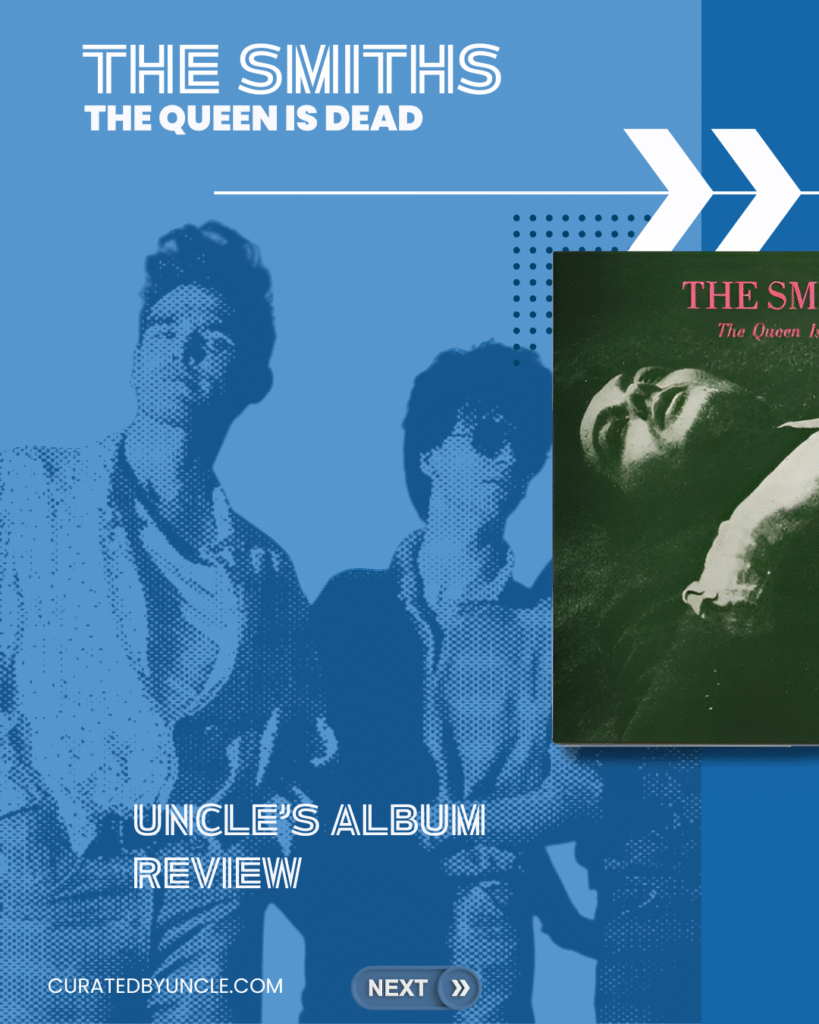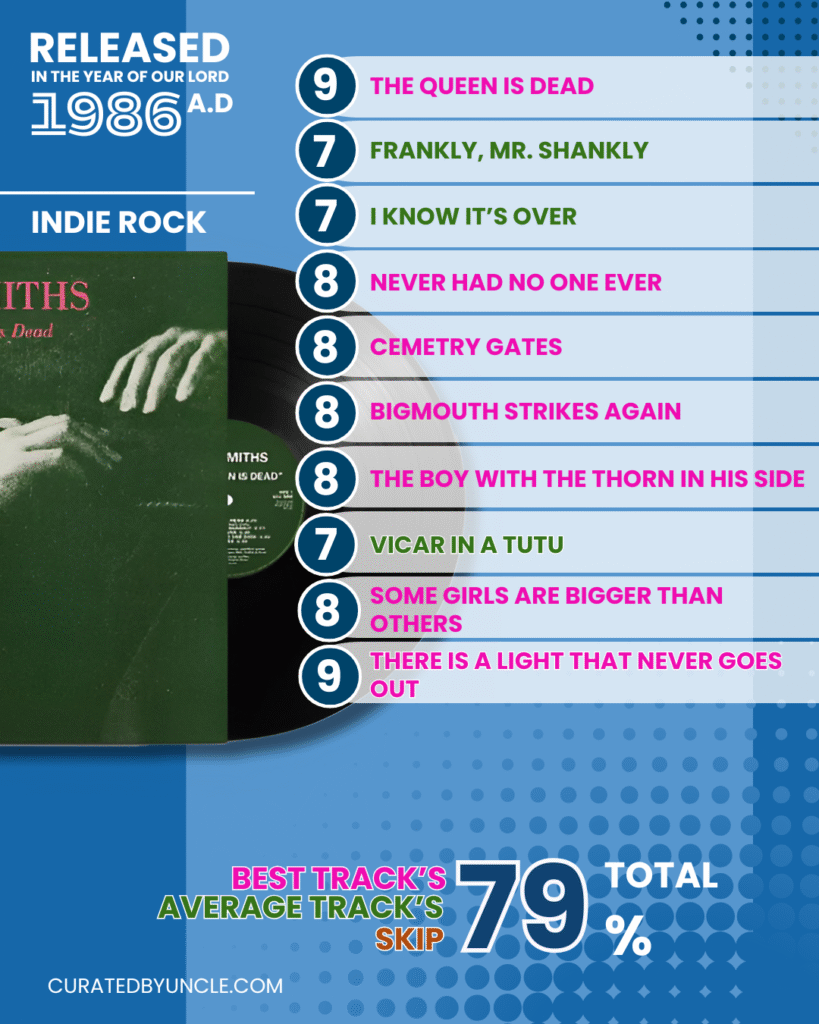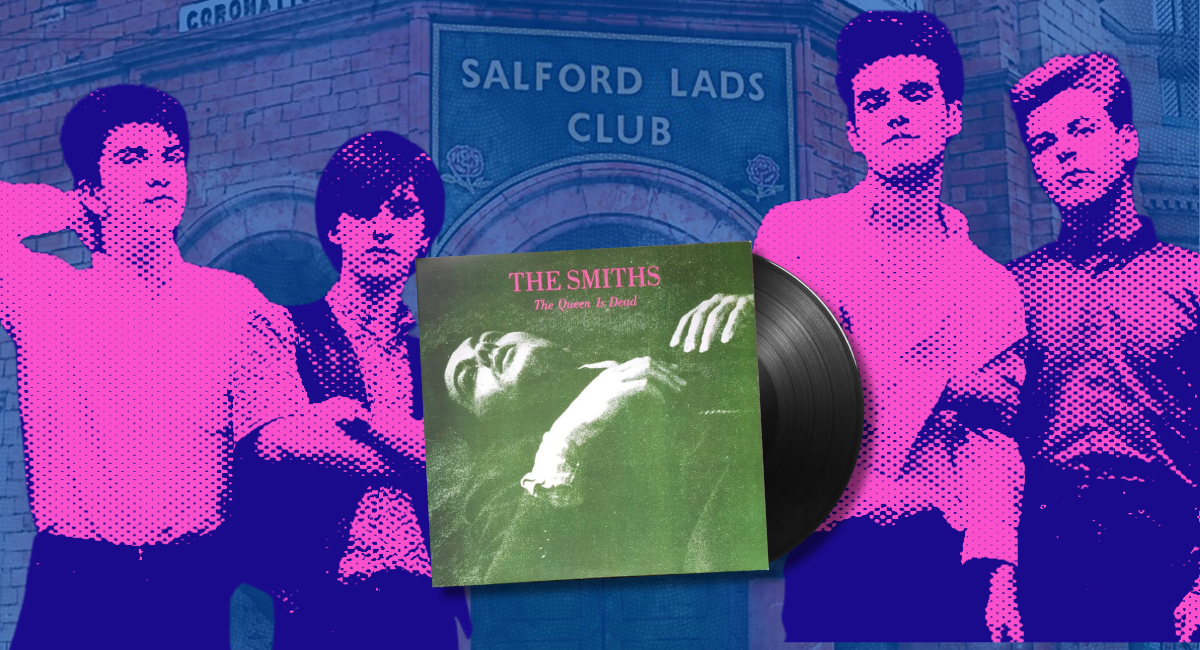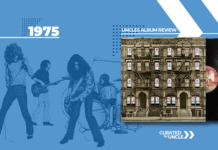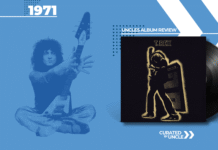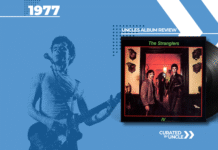The Queen Is Dead (1986): Her Majesty’s Been Slain by a Mancunian Poet with a Quiff
In 1986, while Thatcher was still stomping on miners like she was auditioning for a villainous role in Mad Max, The Smiths released The Queen Is Dead. Not so much a protest album as a poetic evisceration of everything sacred – royalty, romance, consumerism and yes, the tedious pain of simply existing.
It’s indie rock at its most majestic and miserable. Johnny Marr turns his guitar into a jangly weapon of mass melancholia while Morrissey croons like a pub prophet with a thesaurus and a persecution complex. You don’t listen to The Queen Is Dead, you wallow in it – and somehow feel better for it.
Table of Contents
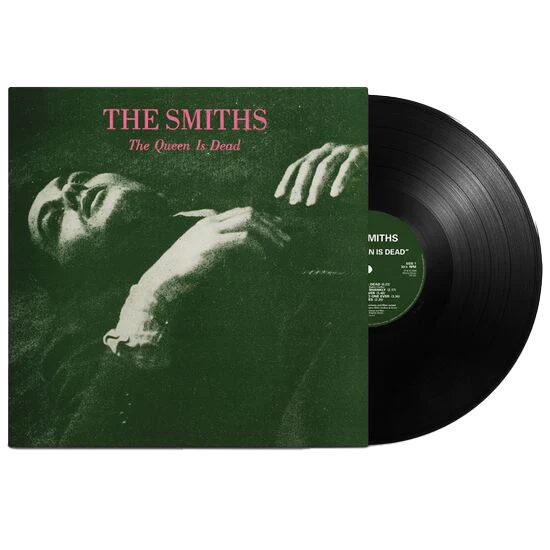
That Title: Casual Regicide, Anyone?
I can’t ignore the elephant in the title. The Queen Is Dead is the kind of album name that would get you blacklisted from royal garden parties and the Daily Mail’s Christmas card list. But the irony is rich: it’s not about Her Maj per se. It’s about the decay of British values, the rot under the bunting, the idea that institutions we’re supposed to worship are, in fact, pants.
And yes, in case you were wondering, it’s aged like a bottle of vindictive wine. Long live the cynicism.
Track-by-Track: A Guide Through the Bleakly Beautiful
1. The Queen Is Dead
The album opens with a sprawling, sarcastic epic. Morrissey kicks in the royal front door with lyrics like “her very Lowness with her head in a sling,” while Marr’s guitars sound like a stampede of sarcasm and snark. It’s part punk, part gothic novella, part drunken rant in a Wetherspoons toilet.
2. Frankly, Mr. Shankly
Ah, the sound of someone quitting their job in song form. A bitter, bouncy middle finger to record executives and corporate drones alike, Morrissey’s delivery is pure spite wrapped in charm. If you’ve ever wanted to say “I’d rather be a poet than a successful wage slave,” but with rhyming insults, this one’s for you.
3. I Know It’s Over
The gold standard for heartbreak anthems, this one is so tragic it should come with a health warning. Morrissey’s vocals bleed over Marr’s skeletal guitar as he ponders dying alone. Relatable? Unfortunately. Uplifting? Not even slightly. Beautiful? Absolutely. It’s like being hugged by a ghost.
4. Never Had No One Ever
If loneliness were a song, this would be its national anthem. Morrissey channels every awkward night out, every rejected glance and every “I’m not like the others” moment into three-and-a-half minutes of glorious wallowing. You’ll want to drink tea in the dark after this.
5. Cemetry Gates
One of the few upbeat-sounding moments, this track sees Moz strolling through a cemetery and pondering plagiarism and dead writers. Morrissey mocking people for quoting Wilde while… quoting Wilde? Peak Morrissey. It’s smug, it’s clever, it’s brilliant.
6. Bigmouth Strikes Again
Here, Moz admits he talks too much and causes trouble, then immediately proceeds to do it again. It’s fast, fierce and one of Marr’s finest moments on guitar. “Now I know how Joan of Arc felt” he sings, presumably moments before alienating another group of fans. But you can’t argue with the tune – it’s an indie banger drenched in acid.
7. The Boy with the Thorn in His Side
A metaphor so on-the-nose it might as well be a slap, this is Morrissey at his wounded best. Misunderstood, unloved and yearning to be heard – basically, the Smiths in four minutes. Somehow this ache becomes a soaring melody. Magic, but bleak magic.
8. Vicar in a Tutu
Suddenly, we’re in surreal comedy territory. A clergyman in drag, prancing through a rockabilly rhythm. It’s camp, cheeky and delightfully odd. It’s also one of those rare moments where the band remembers humour exists. Briefly.
9. Some Girls Are Bigger Than Others
The album ends on a bafflingly breezy track about… bust sizes. Maybe it’s social commentary. Maybe it’s satire. Maybe Morrissey just got bored. But it’s catchy and fun in a “did he really just say that?” way. The perfect comedown after all that poetic misery.
10. There Is a Light That Never Goes Out
In my opinion, one of the greatest love songs ever written about wanting to die in a bus crash. Seriously. “To die by your side is such a heavenly way to die” is as beautiful as it is disturbing. It’s dramatic, adolescent and utterly timeless. The indie wedding song for people who think Valentine’s Day is a capitalist con.
Impact: The Album That Launched a Thousand Cardigans
The Queen Is Dead wasn’t just a critical darling – it was a cultural bombshell. It redefined what “indie” could mean, set the standard for lyrical introspection and gave awkward teenagers everywhere a reason to embrace their gloom.
It also cemented the Smiths as legends and laid the foundation for every eyeliner-wearing, vegan-curious, politically disillusioned band that followed. Radiohead? Wouldn’t exist without it. Arctic Monkeys? Owe them a pint. Your mate with a record player and superiority complex? Definitely owns this.
Morrissey: The Prophet, the Problem
I can’t ignore it – Morrissey has since become a human comment section, full of opinions better left unexpressed. But in 1986? He was the voice of the weird, the lonely, the disenchanted. And The Queen Is Dead was his divine sermon.
Production Notes & Background: The Bitter Birth of a Classic
Recording started in late 1985, mostly at Jacobs Studios in Farnham and Britannia Row Studios in London. The band was at the height of their powers – artistically tight, personally frayed. Morrissey was locked in a spiritual battle with the world and Johnny Marr was juggling creative euphoria and burnout like a caffeinated wizard.
Producer Stephen Street handled engineering and mixing, laying the groundwork for what would later become the signature Britpop sound. Marr’s layered guitars – bright, chiming and impossibly intricate – were offset by a rhythm section that was tight and under appreciated (shout-out to Andy Rourke and Mike Joyce, the Smiths’ unsung rhythm gods).
But the real nightmare wasn’t technical – it was legal. The Queen Is Dead was delayed by endless lawsuits between The Smiths and Rough Trade Records. At one point, Morrissey was so annoyed he threatened to retire. (Foreshadowing his future as a professional grievance machine.)
The Cover Art: Morrissey’s Morbid Muse
The cover is pure Morrissey: La Jetée meets Cemetery Junction. It features French actor Alain Delon from the 1964 film L’Insoumis – hand-picked by Moz himself from his VHS collection of moody French cinema and unresolved daddy issues.
This wasn’t just style over substance. Morrissey used visual cues to align The Smiths with high art, old cinema and the kind of melancholia that required a beret and a cigarette holder.
Chart Performance: Success in Spite of Everything
Despite minimal radio support and the band’s refusal to play the fame game, The Queen Is Dead reached No. 2 on the UK Albums Chart and eventually went platinum. In the US, it fared less well commercially but later gained legendary cult status, especially among disaffected teens and music critics with trust issues.
Legacy: A Blueprint for Misery and Melody
It’s no exaggeration to say The Queen Is Dead changed British music. It was:
- #1 on NME’s 500 Greatest Albums of All Time
- #218 on Rolling Stone’s 500 Greatest Albums (2020 list)
- Inducted into practically every hipster’s turntable by the age of 19
It’s the DNA of Britpop, the shadow under indie rock and the reason countless introverts tried to learn guitar and failed.
Trivia for Smiths Nerds:
- Morrissey wrote many of the lyrics in cemeteries. Not metaphorically. Literally. With a notebook.
- The title track includes a sample of “Take Me Back to Dear Old Blighty” from a 1962 musical, sung by Cicely Courtneidge. Because of course it does.
- “Some Girls Are Bigger Than Others” contains one of the band’s cheekiest uses of fade-ins and fade-outs, making it sound like the engineer was drunk.
- Marr claimed he composed the riff for “There Is a Light That Never Goes Out” while thinking of The Rolling Stones’ “Walk On By.” You can hear that bittersweet grandeur bleeding through.
Deeper Interpretation: Morrissey, Mortality & Monarchy
The album title isn’t just anti-royal snark – it’s an obituary for British identity. Morrissey dismantles false idols (the crown, religion, the romantic ideal) and replaces them with brutal honesty, deadpan humour and moments of swooning despair. It’s like if Oscar Wilde was reborn as a vegetarian with abandonment issues.
Johnny Marr, meanwhile, performs some kind of musical exorcism. His melodies soar and shimmer, even when the lyrics are chewing razor blades. The tension between beauty and bitterness is what makes the album eternal.
My Final Thoughts: Still Majestic. Still Miserable. Still Essential.
The Queen Is Dead is one of the few albums that can make you laugh, cry and question the monarchy in under 40 minutes. It’s as relevant today as it was in 1986 – a melodic middle finger to conformity and an eternal love letter to misfits everywhere.
So light a candle, clutch your copy of Oscar Wilde’s Greatest Hits, and press play. Just… maybe avoid the bus.

If You Like The Queen Is Dead, I Recommend These Albums:
- Suede – Dog Man Star: Glamour, gloom, and glorious guitar flourishes.
- Belle and Sebastian – If You’re Feeling Sinister: Twee misery in a sweater vest.
- Radiohead – The Bends: Sad lads with riffs—Moz would have approved, begrudgingly.
